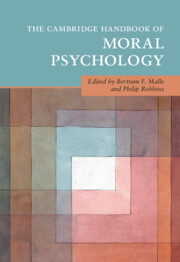Book contents
- The Cambridge Handbook of Moral Psychology
- Cambridge Handbooks in Psychology
- The Cambridge Handbook of Moral Psychology
- Copyright page
- Contents
- Figures
- Tables
- Contributors
- Preface
- 1 Modern Moral Psychology
- Part I Building Blocks
- Part II Thinking and Feeling
- Part III Behavior
- Part IV Origins, Development, and Variation
- 17 Grounding Moral Psychology in Evolution, Neurobiology, and Culture
- 18 Moral Babies? Evidence for Core Moral Responses in Infants and Toddlers
- 19 An Integrative Approach to Moral DevelopmentDuring Adolescence
- 20 Morality in Culture
- Part V Applications and Extensions
- Index
- References
20 - Morality in Culture
The Fate of Moral Absolutes in History
from Part IV - Origins, Development, and Variation
Published online by Cambridge University Press: 20 February 2025
- The Cambridge Handbook of Moral Psychology
- Cambridge Handbooks in Psychology
- The Cambridge Handbook of Moral Psychology
- Copyright page
- Contents
- Figures
- Tables
- Contributors
- Preface
- 1 Modern Moral Psychology
- Part I Building Blocks
- Part II Thinking and Feeling
- Part III Behavior
- Part IV Origins, Development, and Variation
- 17 Grounding Moral Psychology in Evolution, Neurobiology, and Culture
- 18 Moral Babies? Evidence for Core Moral Responses in Infants and Toddlers
- 19 An Integrative Approach to Moral DevelopmentDuring Adolescence
- 20 Morality in Culture
- Part V Applications and Extensions
- Index
- References
Summary
This chapter proposes a way to investigate and evaluate the moral standing of cultural customs different from one’s own without falling into ethnocentrism. As a methodological approach the authors adopt the perspective of “moral realism,” which is the view that there are absolute moral truths that supply all human beings with good reasons for their judgments about what is right or wrong and possess a normative authority that supersedes social consensus and personal desire. According to the authors genuine moral absolutes are abstract forms that provide the skeletal structure for the development of any genuinely moral cultural tradition; while it is their fate to be specified and implemented locally and to assume an historically provincial moral shape. To illustrate this relationship between moral reality and cultural specificity, the authors analyze several ethnographic examples of distinctive and even clashing moral traditions. These include clashes between Brahman Hindu Indian and Western secular views of a widow’s obligations and tensions between Native American whalers’ and whaling protesters’ attitudes toward whaling.
Keywords
- Type
- Chapter
- Information
- The Cambridge Handbook of Moral Psychology , pp. 492 - 520Publisher: Cambridge University PressPrint publication year: 2025

